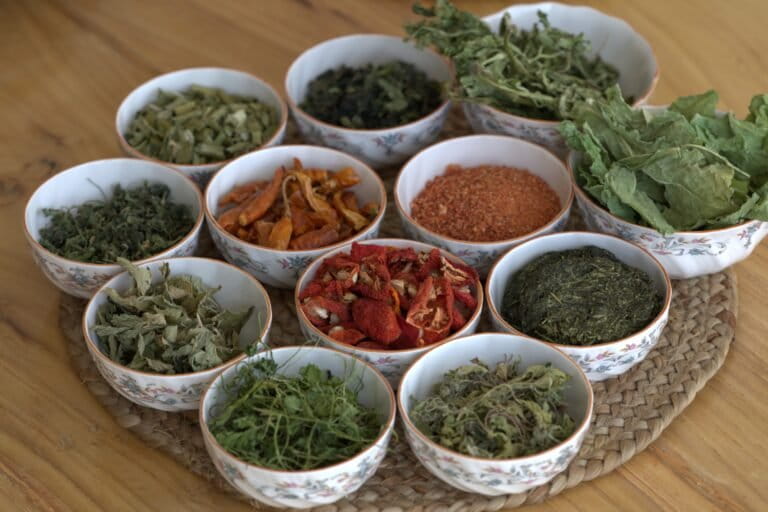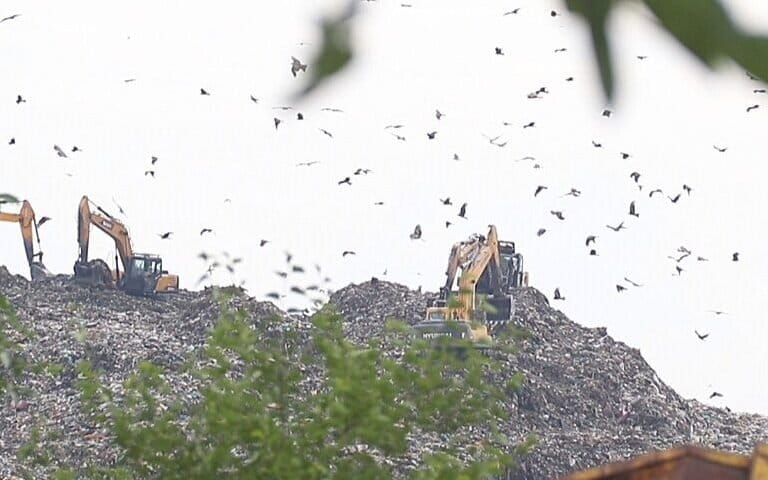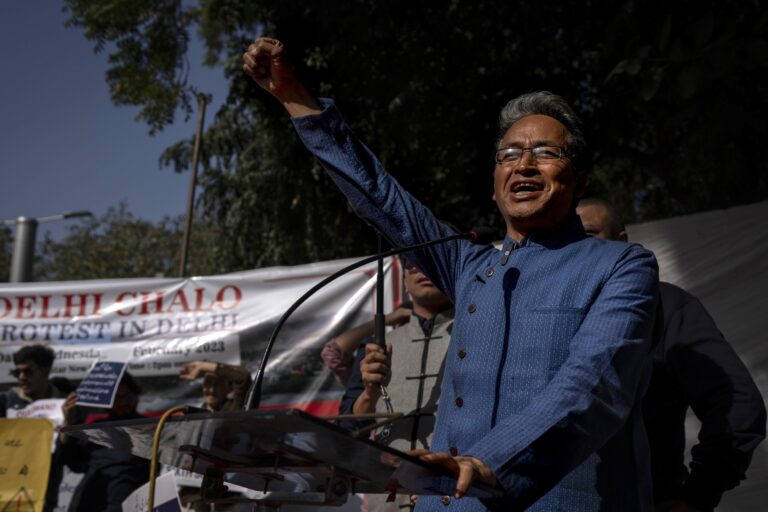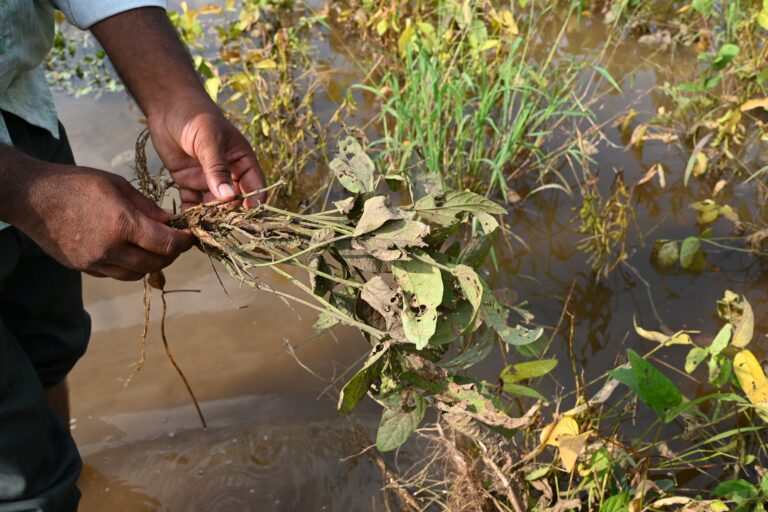- An increase in the consumption of tender coconut and its products is leading to an increase in tender coconut husk in landfill sites and on road corners.
- Solid waste management experts say that there are technologies to recycle tender coconut husk into value added products, but the lack of source segregation makes their retrieval difficult.
- The cost and space constraint of tender coconut waste processing technologies and lack of government support, discourages entrepreneurs from investing in the processing of a single item.
Udaiveer Singh has been running a tender coconut stall in Nangal, a city in Punjab, for six years now. He buys 1,200 coconut pieces every six days from an agent in Jalandhar, who, in turn, gets his supplies from Karnataka. “Initially, people would consume tender coconut water only during summers. So, I sold fruit juice in the winters. However, in the last two years, tender coconut has remained in demand throughout the year,” said Singh. There are about 10 tender coconut stalls in a row in Nangal in Rupnagar district, a city at the foothills of the Himalayas.
All the stalls pile up the leftover tender coconut husks under a nearby tree. Once a week, a mini truck from Jinda Jeev Be Sahara Charitable Society, an old-age home in the city, picks them up. “We collect about 1.5 metric tons per week. We dry this husk in the sun for two months and then we use it as a cooking fuel. At six rupees per kilo, wood is too expensive,” said Ashok Sachdeva who runs the old-age home.
While tender coconut vendors in Nangal can last a week without their waste being picked up, their counterparts in bigger cities can’t afford to do so, owing to lack of space. While Ajay Raj in West Delhi goes to the nearest garbage dump each evening to throw away the husk, Giri in Chennai has his waste picked up by a private contractor who takes it to a processing facility. “Sometimes, we have to pay the contractor to take it away,” said Giri.

Tender coconut husk is biodegradable but it is hard husk. It takes a long time to degrade owing to its high moisture content and size. As the urban population takes to this healthy drink, especially during summers, the rising pile of leftover tender coconut husk is becoming a nuisance of sorts.
Technologies to effectively reuse the husk to create value added products such as compost, paper making, sofa stuffing and more, do exist, but the root of the problem lies in the lack of source segregation of waste. According to waste management experts, the commitment of civic bodies towards managing special category wastes such as tender coconut, needs improvement.
“All stakeholders – citizens, waste collectors and processing agencies -need to come together for effective segregation, but only the government holds the switch when it comes to enforcing it,” said P. Natarajan, founder of Namma Ooru Foundation, a non-profit working on waste management in Chennai.
The trendy beverage with health benefits
Tender coconut water was always popular as a beverage, but during the COVID-19 pandemic, people became more health conscious and realised its potential for rehydration. “It is a rage even in north Indian states, where traditionally tender coconut water was not consumed. Now, about half of Karnataka’s tender coconut is transported to other states. I have clients who follow specialised diet systems such as ketogenic (keto) and regularly consume tender coconut water twice a day,” shared Swetha Sandesh, director of Niranthara Cokonut that sells packaged tender coconut products such as coconut water, coconut meat and ice-creams.
According to Sandesh, people are paying even Rs. 80-90 a piece in cities now. “They want it in the comfort of their homes so home deliveries have also gone up and companies with packaged tender coconut water are running good business,” she added.
“Consuming tender coconut water, its ice cream and other products was not really a trend in Kerala some five-six years ago, even though almost all houses here have a coconut tree. Even in the last few years the tender coconut for these products comes from Tamil Nadu, the vendors tell us. That is because coconut oil is so expensive and we consume more of that from our coconuts,” said Arathi Ranjith, a documentary film maker from Kerala.
Tender coconut water has the same level of electrolytic balance as in human blood. It contains sugars, minerals and minor amounts of nitrogenous compounds besides potassium, its primary nutrient. It therefore helps to maintain blood volume, heart health, prevent dehydration and stress.

India is among the three largest coconut producing countries in the world, the other two being Indonesia and Philippines. In 2021-22, with an annual production above 19,000 million nuts, India accounted for 31.45% of the world’s total coconut production. Even as area under coconut cultivation is higher in both Indonesia and Philippines, India, at 9,123 nuts per hectare, has a higher productivity than both these countries whose per hectare productivity is around 4000 nuts per hectare. Also,17 states in India have coconut plantations but 90% of production is from Kerala, Tamil Nadu, Karnataka and Andhra Pradesh. Karnataka, at 30.83%, is the biggest producer. Maddur in Mandya district between Bengaluru and Mysore is the biggest wholesale market for tender coconut in India.
Processing tender coconut waste
Only 20% of a tender coconut is edible, so the rest has to be discarded. K. S. Raja runs Vizag Bioenergy Pvt Ltd in Andhra Pradesh’s Vishakhapatnam. The company makes compressed biogas (CBG) from organic waste. “We were allotted land in a landfill site. When we began construction, the legendary waste we dug out was mostly tender coconut waste. It was totally intact, except a little discolouration,” said Raja. CBG plants discard tender coconut husk at the first stage of their process.
Municipal corporations that outsource door-to-door waste collection, fix the tipping fee on weight basis. “Contractors would just pick up tender coconut husk as it is heavy and mostly leave the other waste. That’s why cities which are now working to treat their legendary waste, are finding a lot of tender coconut husk there,” said a solid waste management (SWM) expert from Chennai, on conditions of anonymity.
In Bengaluru, 200-300 metric tons of tender coconut waste is produced each day, informed an official of Bengaluru SWM Ltd, an arm of the Bruhat Bengaluru Mahanagara Palike (BBMP), on condition of anonymity. There are two tender coconut waste processing facilities in the city that process about 30-40 tons per day (TPD) of the waste and the BBMP is considering building another larger facility of 100 TPD capacity on a public-private partnership basis.
“About 150-200 tractors full of tender coconut are taken away by farmers from nearby villages every day, who use it as a cooking fuel. Informally, the tender coconut waste is diverted before it reaches the waste management system of BBMP,” said the official.
The tender coconut husk shredding facilities separate pith from fibre. The first step is to crush the husk into smaller pieces and then into a fine powder. After this, fibre and pith are separated using a mesh. A heavy motor is required to shred hard particles like tender coconut. The pith is the powder from which coco-peat is made besides incense sticks and briquettes. The fibre of tender coconut is short (as the coconut is chopped at the top) and immature as compared to the mature coconut fibre. The mature coconut’s fibres are extensively used in the coir industry in Kerala.

“We compost the pith from tender coconut husk to make coco-peat that goes to gardens, nurseries and for landscaping. The fibre is sent to hatcheries to make beds for chicks and also for sofas and mattresses,” said Harshith Reddy who runs SM Enterprises that has a capacity to process 30 TPD of tender coconut waste. Reddy started his facility in 2019 and says that he has been facing several challenges since then. “Initially, the wet waste contractors did not let us take the husks as their tipping fee was affected by it. I have to run the plant in a rented premises and all my machines are on diesel,” said Reddy.

According to Reddy, given the capacity of his facility, the main thing they do is prepare the raw material like pith and fibre and then give it further to other manufacturers who make various products with it. Pith is mostly sent to compost plants.
Likewise, different cities have different arrangements to process tender coconut husk. In Mumbai, the Municipal Corporation does not accept it directly from vendors. So, the vendors either pay for it to be lifted or tie up with processors. However, processors also think twice to collect from places that far away, because the cost of transportation cuts into their profits. In Chennai, it’s either the processors who pick it up at a cost or the one that is dumped on roadsides is taken by the municipal corporation employees to a recycling facility, from where it is picked up by recyclers again.
“Tender coconut husk is useful only if collected separately,” said Kalyanee Paranjape, Coordinator at Chintan Environmental Research and Action Group, a non-profit in Delhi that facilitates women self-help groups to make compost using tender coconut husk as the base mixed with other biodegradable material, under their brand Magic Mitti. “We add a layer of tender coconut husk as the base layer in our compost pit as it is rich in moisture and provide aeration and structure to the compost pile. But it is difficult to find people who give their tender coconut husk to us directly rather than throwing it in mixed waste. Once it reaches the landfill, it is of no use as it gets contaminated with biomedical waste as well. Landfills everywhere are overflowing with waste and tender coconut husk occupies the space there, generating emissions. If the tender coconut is picked up directly from source, this whole journey to the landfill can be prevented and the husk can be put to better use,” explained Paranjape.
Watch: [Video] Can a waste-to-energy plant address piling concerns from a landfill site?
Solutions that need scaling-up
Tender coconut husk is made of fibers that comprise lignin (30-42%) and cellulose (54-65%) and also traces of tannin and potassium. Drying a tender coconut husk to use as a fuel source, takes six months. With its quantities going up in medium and large cities, other technological interventions have come up.
The Coir Board of India, under the Ministry of Small, Medium and Micro Enterprises, has made headways in isolating lignin and cellulose from tender coconut husk. “The lignin can be converted into lignosulphonate that has huge industrial application. Right now, we are importing it from Germany and China. The cellulose can be used to develop adsorption products for biomedical applications like wound dressing, scaffolds and diapers,” S. Radhakrishnan, Senior Scientific Officer at the Central Coir Research Institute, Kerala, told Mongabay-India. Sodium lignosulphonate has multiple uses in lead acid batteries, as mud thinners in oil well drilling fluids, binder in roads, in animal feed preparations, as dispersal agent in cement manufacture and as anti-caking and tanning agent.
“One can make paper, room fresheners, disposable crockery, incense sticks and activated charcoal. The compost of tender coconut gets ready in 60-90 days as compared to 30 days for normal coir pith. The Coir Board has developed all these technologies and we keep displaying them in our seminars and exhibitions for entrepreneurs to take up commercially,” Radhakrishnan added.

Studies say that chemicals naturally available in the tender coconut husk pith allow it to be hot pressed into a binder-less particle that can be used as a wood substitute and also as briquettes. They have low ash content, no smell, are easy to transport.
However, on ground, there are few takers of these technologies, thanks to the cost of electricity. “Even ethanol can be extracted by crushing tender coconut husk but all these technologies require huge capital,” said Reddy. “I haven’t found a single model where tender coconut has been dealt with successfully. Five years ago, a Goa-based biogas plant approached us to ask if we have a solution as they had a huge pile collecting,” said M. Shankar, owner of Arsta Eco Pvt Ltd, a company in Karnataka’s Tumkur that makes biochar and biocarbon from mature coconut husk and shell. “The challenge with tender coconut is its high moisture content. It takes a lot of energy to dry, making it economically unviable. Not many people are interested in investing so much for a single product,” said Shankar.
Sandesh set up Fibware to reinvent leftover tender coconut husk from her company into disposable crockery. “We separate the husk into pith and fibre and thermo-press the fibre along with a food-grade binder to make this crockery. We are still at the initial stage, so the scale is small and the cost of production is high. With fully automatic machinery and bulk production, soon we will be competing with areca palm plates,” said Sandesh.
A plate made with tender coconut fibre costs Rs. 20 as of now as compared to Rs. 10 for a plate made with areca palm, Sandesh informed. “Our electricity costs is Rs. 10-12 per kg. Even though we can dry them in the sun, we also need to use machines which need electricity,” she said. According to Reddy, for the kind of high-powered machines required to shred tender coconut, the power cost for his facility itself would be Rs. 45 lakhs a year. “I can’t even take that connection in a rented premises,” he shared.

While high energy input technologies delays scaling up of innovations to process tender coconut, Natarajan of Namma Ooru Foundation says that setting up multiple micro-composting facilities is the solution. “Tender coconut processing requires space if done at a large scale and cities always lack that. Our facility collects 100-200 pieces every day and converts it into brown matter for compost by shredding it and mixing with dry leaves and sugarcane residue. This brown matter is high in carbon and when mixed with the other organic waste that is rich in nitrogen, it creates quality compost. Many farmers buy just brown matter from us as the fibres store water and saves the soil from weeds,” said Natarajan.
With additional inputs from Aparna Hakin and Sumana Narayanan.
Banner image: Tender coconut waste piled up on the roadside in Nangal, Punjab. Photo by Ravleen Kaur.














